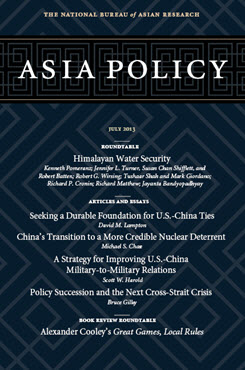Melting the Geopolitical Ice in South Asia
This is one of seven essays in a roundtable that discuss the challenges and implications of water security in Asia and recommend steps that both upstream and downstream countries could take to better manage the region’s shared water resources.
No one doubts that the six mainland states of the South Asian Association of Regional Cooperation (SAARC)—Afghanistan, Bangladesh, Bhutan, India, Nepal, and Pakistan—harbor an abundance of varied water-resource problems, with a steadily mounting scarcity of freshwater ranking high among them. Because the South Asian region is laced with an array of transboundary rivers vital to the economies of these states, few doubt either that these problems have a geopolitical dimension. There has been vigorous argument about the scale and intensity of this dimension, fed to some extent by mass media-provoked alarm over the imminence of “water wars.” While some skepticism is unquestionably warranted in this regard, the weight of informed opinion today, encouraged by a stream of sober warnings from both official and unofficial sources, recognizes that there is a clear and present danger of serious interstate tension caused by transboundary water disputes. Adding immeasurably to the urgency and uncertainty of deliberations on the region’s water circumstances are two further developments: the longer-term and clearly menacing consequences of climate change, and the shorter-term and worrisomely quickening pace of China’s dam construction on transboundary rivers shared with South Asia. Under these circumstances, no wonder that many water experts are questioning whether South Asia has in place bilateral and multilateral frameworks adequate to the task of managing the region’s increasing water insecurity. The record of interstate relations in this region over the past few decades offers meager assurance in this regard, but there are recent signs that governments are awakening both to the dangers of water insecurity and to the need for interstate cooperation in coping with them.
The Scarcity of Water in South Asia
Even a limited sampling of recent expert studies leaves practically no room for doubt about the magnitude of the region’s problem of freshwater scarcity. A 2009 study by the 2030 Water Resources Group estimated, for example, that demand for freshwater by 2030 in vastly more populous and urbanized India would grow to almost 1.5 trillion cubic meters—about double its current water supply. “As a result,” the group observed, “most of India’s river basins could face severe deficit by 2030 unless concerted action is taken.” [1] A comprehensive 2013 tri-nation study of the water resources of the Indus Basin gave a similarly dire forecast. With India’s population expected to approach 1.7 billion by 2050, and Pakistan’s likely to reach nearly 275 million by the same date, the annual availability of renewable water per capita across the basin (with a total population by then of about 383 million) could dip below 750 cubic meters—an internationally recognized threshold for severe water scarcity. [2]
Water resource conditions in the Ganges-Brahmaputra-Meghna Basin—the world’s second-largest riverine drainage basin—differ significantly from those found in the Indus Basin but are also largely discomforting. Admittedly, a major recent study of water scarcity in Bangladesh contains some encouraging news. Examining meteorological data gathered from the 1940s to the present, the study finds that annual rainfall totals have held fairly constant. It also reports that only on one of the three major transboundary rivers for which data was collected—the Padma/Ganges—have changes in upstream hydrological patterns (such as rainfall, glacial melt, and water drawing or diversion) caused significant variation over time in dry season flow. However, given the importance of that river to southwestern Bangladesh, the study’s finding of a more than 20% decline in the dry season flow since 1960 holds extremely serious consequences for the country’s groundwater recharge and agricultural productivity. [3]
What this study’s findings highlight is Bangladesh’s exceptionally unfavorable freshwater dependency ratio. The country draws an estimated 91.4% of its surface water from 57 out-of-country rivers feeding into it (primarily from India and China). In other words, decisions made by…
[1] 2030 Water Resources Group, “Charting Our Water Future: Economic Frameworks to Inform Decision-Making,” 2009, 10, http://www.mckinsey.com/App_Media/Reports/Water/Charting_Our_Water_Future_Full_Report_001.pdf.
[2] Indus Basin Working Group, Connecting the Drops: An Indus Basin Roadmap for Cross-Border Water Research, Data Sharing, and Policy Coordination (Observer Research Foundation, Stimson Center, and Sustainable Development Policy Institute, 2013), 18, available at http://www.stimson.org/books-reports/connecting-the-drops./
[3] Kristian Hoelscher, “Trends in Rainfall and River Flows: Changing Ground Realities?” in Ashild Kolas et al., “Water Scarcity in Bangladesh: Transboundary Rivers, Conflict and Cooperation,” Peace Research Institute Oslo (PRIO), PRIO Report, 2013, 47-54, http://www.prio.no/publications/waterscarcity.
About Asia Policy
Asia Policy is a peer-reviewed scholarly journal presenting policy-relevant academic research on the Asia-Pacific that draws clear and concise conclusions useful to today’s policymakers. Asia Policy is published quarterly in January, April, July, and October and accepts submissions on a rolling basis. Learn more


